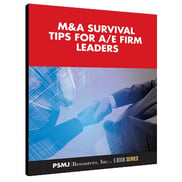
Post-transaction integration is a term that means different things to different people. For some buyers, every transaction is followed by swift and comprehensive integration. The name, accounting systems, project management practices…it all becomes one. In other cases, it is a very gradual and limited process where the seller may continue to operate quite independently.
Most buyers (and sellers) will attest that every case is different and, accordingly, each transaction brings with it certain constraints and objectives. However, no matter where your next transaction falls on the integration continuum, there are some pointers that apply to just about every transaction. Along these lines, below are three tips to help you get the most out of your integration efforts:
-
Get boots on the ground. Even if the plan is for very little formal integration, this is a people-based business and one of the fundamental goals will be to ensure cultural alignment between the two organizations. Particularly with deals that are a geographic expansion move, the odds of success get a whole lot better when you have a senior manager willing to relocate to the seller’s region to create consistency and keep a focus on achieving the transaction objectives. This is often a great move for up-and-coming leaders looking to make their mark in the organization or senior leaders interested in changing their role (e.g. move to a more appealing climate) as they begin to contemplate retirement.
-
It doesn’t have to be a one-way street. Some of the most active acquirers in the industry will tell you that they pick up a new idea or best practice from just about every transaction. More specifically, the goal isn’t to push practices and procedures unilaterally onto the seller. Rather, the goal is to extract the best DNA from both firms to create something better.
-
Build a better mousetrap. They say practice makes perfect and that couldn’t be truer in M&A. For everything that you do right or that works well, remember it! Once the deal has been digested, review what worked and what didn’t and use that intelligence to build a more consistent and effective process for future transactions. This will make the next one faster, smoother, and it might even just make it more affordable.
The tips for a successful integration don’t stop here. Spelling out clear objectives, building an integration team…the list goes on. But, you need to start somewhere and above are a few tips that some of the most battle-tested M&A experts will attest to as “must haves” for successful growth through acquisition.
Looking for more strategies and tips for M&A success? Check out a A/E/C Mergers and Acquisition Roundtable …two days of case studies, data, advice, and more!
 Merger & Acquisition (M&A) activity in the architecture and engineering space is certainly on the upswing and well on its way to reaching pre-recession levels. But, how ready are you for taking on the task of buying or selling an A/E firm? If you are looking for tips to help your firm navigate through the M&A process, check out PSMJ complimentary ebook M&A Survival Tips for A/E Firm Leaders.
Merger & Acquisition (M&A) activity in the architecture and engineering space is certainly on the upswing and well on its way to reaching pre-recession levels. But, how ready are you for taking on the task of buying or selling an A/E firm? If you are looking for tips to help your firm navigate through the M&A process, check out PSMJ complimentary ebook M&A Survival Tips for A/E Firm Leaders. 
Other M&A Related Posts
Getting Ready to Sell? Think Like a Buyer!
What You Must Know About Private Equity
Growing Revenue = Growing Valuation? Be Careful What You Wish For!
Expert Interview: Assessing Current M&A Market Conditons and Trends
How prepared are A/E firm leaders to undertake M&A?




